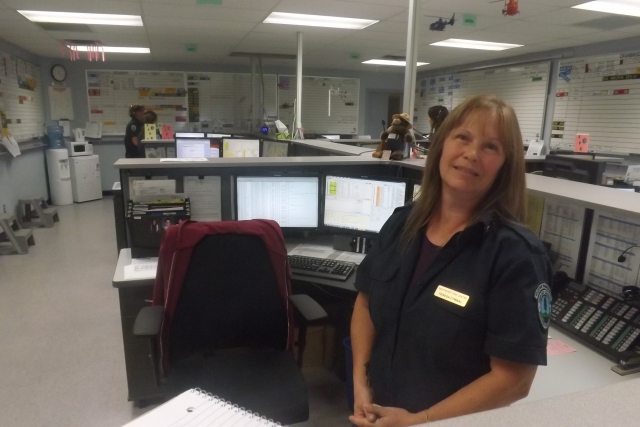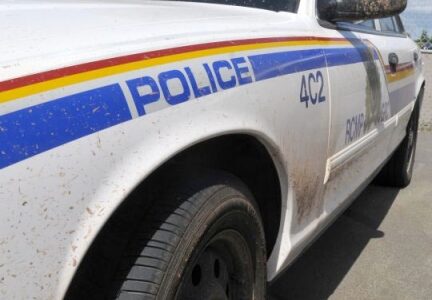Unsung heroes - a salute to the staff at the Southeast Fire Centre
The Southeast Fire Centre’s main building is a fairly unremarkable one-story government structure – although made significantly more cool by the airport watchtower beside it and the back lot filled, not with cars and trucks, but rather with helicopters and sometimes air tankers.
When you first walk in, you see the standard institutional warren of offices and cubicles, but the walls are covered with dramatic, even arresting photos taken by firefighters in the front lines (these will comprise an art exhibit at the Kootenay Gallery starting Sept. 25, and they are not to be missed).
The coolest part of the place, though, is the group of men and women who work there.
The firefighters and pilots get a ton of public gratitude and adulation – as is right and good, given they’re putting their very lives on the line every time they go near a blazing wildfire. But they’re not the only dedicated people going without sleep, sometimes without meals and working outrageous hours far from their families to protect this fire district.
Someone has to identify and pinpoint fire locations, equip the aircraft with fuel, water and retardant, coordinate staffing and heavy equipment deployment, pay the bills and sign the paycheques, deal with the public and the media … the list goes on. As of last Friday, there were 290 employees working out of the Southeast Fire Centre.
Take, for example, Jennifer Weeks and Matthew Schneider, both loader techs, who have both worked unbelievable overtime to provide aircraft with 2,166,178 litres of water/retardant-combination between May I and last Friday.
Then there’s Ron Lakeman, fire weather forecaster, who, during last Friday’s tour, predicted the cooler, wetter weather that has provided our region with so much relief in the past five days. Or how about Jackie Gagnon, in Logistics, who coordinates contract crews and heavy equipment, resource requests, mop-up crews, danger-tree fallers and first aid units.
There’s the planning department, where information management includes keeping track of people, providing current maps, and forecasting centre needs. “We fight fire with paper,” said one planning staffer.
The dispatch centre is a bustling – and baffling – nerve centre within the larger building. Teresa Cymbal was working as supervisor on Friday, and she tried to explain, in brief, the overwhelming array of colour-coded charts adorning every wall, the four computer screens on every desk, the flurry of urgent conversation and paperwork as anywhere from eight to 10 dispatchers work 24/7 during the peak of the fire season.
This is the place where they process initial calls reporting fires, as communicated by 1-800 line operators in Victoria. They then begin the process of determining a) whether there is a fire b) how big it is and c) what are the best and closest resources to send to tackle it. They coordinate the deployment, movements and safety of everyone from initial attack crews to medics, fallers, unit crews, helicopters, etc. – air tankers are dispatched separately, but their movement is monitored by fire centre dispatch as well.
They manage safety check-ins (helicopters have to check in every half hour, ground crews every hour to four hours, depending on the fire they are attending, etc.)
“Sure, it sometimes means long hours,” Cymbal said. “Scheduling is our hugest pet peeve, because it’s all dependent on fire activity. A shift can start out slowly, and end up being swamped within minutes – there’s no predicting it.
“It means people have to be really flexible and go that extra mile, coming in early and staying late,” she said, adding the status of check-ins is critical to scheduling as well. “We can’t – and won’t – leave until everybody’s in on good roads and safe.”
She said a huge part of the job is regulating your reaction to sometimes very emergent and distressing situations.
“You have to stay calm – if you get ramped up, you communicate that and everyone gets ramped up,” she said. “It’s a huge team in here – everyone looks after everyone.”
Outside dispatch once more, there’s the oh-so-critical finance office, making sure the lights stay on and everyone gets paid, reception, and last (but certainly not least) the fire information officers – those hard-working folks ensuring the media and the public remain informed, and who take calls from media outlets like The Source and The Champion at bizarre hours of the night and weekends. Given their relentless availability, one would think there were many on staff, but there are right now actually only two fire information officers at work – Karlie Shaughnessy and Fanny Bernard. The two do everything from taking calls from concerned members of the public regarding everything from the proximity of fires to homes/structures to size and estimated growth of fires, to compiling data and information for the media, issuing press releases, and even touring reporters around the facility for a behind-the-scenes look like this one. They travel to, and stay on, fire sites like Rock Creek and Stickpin this season, to provide up-to-date information, and they are critical to keeping public panic and hysteria to a minimum.
“This season, I think the public is a little bit more on edge,” Shaughnessy acknowledged, adding the smoke and ash from the Stickpin fire was very disturbing for many residents.
Shaughnessy is the only year-round information officer, and she spends the off season for pre-planning, internal communications, hiring, website management and so forth.
She also digs up data with which to update staff and media each day – for example, many people were commenting on how the 2015 fire season seemed to be even worse than the firestorm of 2003. Shaughnessy was able to confirm that such, at least as of Friday, is not the case after all.
“By this date (Aug. 28) in 2003, there had been 595 wildfires burning 44,680 ha, whereas this year, there have been 558 burning 11,754 ha,” she said, adding the average calculated over five years is 274 fires burning 3,897 ha, so while this year hasn’t been as bad as 2003, it will still be remembered as a brutal fire season.
Brutal or no, it was made infinitely more manageable by the long hours, commitment and dedication of the men and women at the Southeast Fire Centre.
Thank you all.

























Comments